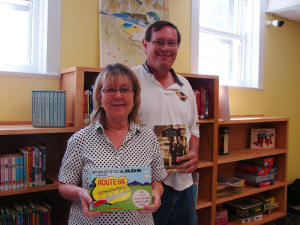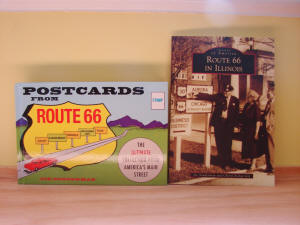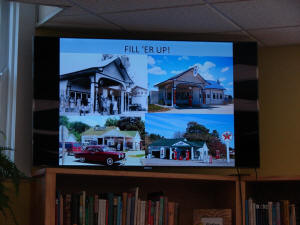
Cheryl Jett and Joe Sonderman |

Books by Joe Sonderman and
Cheryl Jett. |
Authors’ reflections inspire travel over Route 66
 Send a link to a friend
Send a link to a friend
[August 07, 2014]
LINCOLN - Joe Sonderman and Cheryl Jett
stopped by the Atlanta Public Library Sunday, July 27, to discuss
their favorite subject, Route 66. After being introduced by library
co-director Rachel Neisler, the pair took their audience on a
virtual tour of Route 66 as the roadway took shape in Illinois.
Sonderman is employed by the Missouri Department of Transportation
and Jett is a retired music teacher.
Sonderman remembers as a child growing up in St. Louis, his family
would always vacation at Lake of the Ozarks.
|
|
 His father would gather the family in the car and
drive straight through. Sonderman promised himself that when he grew
up, he would stop and visit every town and landmark that appeared
along the highway. That is exactly what he does. To him, the iconic
Route 66 is not a way to get to a destination as quickly as
possible, but traveling on what is left of it and learning about the
history that surrounds the old road is part of his vacation. His father would gather the family in the car and
drive straight through. Sonderman promised himself that when he grew
up, he would stop and visit every town and landmark that appeared
along the highway. That is exactly what he does. To him, the iconic
Route 66 is not a way to get to a destination as quickly as
possible, but traveling on what is left of it and learning about the
history that surrounds the old road is part of his vacation.
When traveling with his family now, they never eat at chain
restaurants and never stay at chain motels. In the early days of the
highway, there was no uniformity along the route as there is today.
“You never knew what cafes were in the next town or where you would
sleep that night. It was part of the adventure,” he said.
Cheryl Jett grew up in Edwardsville and lived one block from Route
66. It always held a fascination for her. She was taught map reading
by her parents, so when they traveled she was in the back seat
navigating with a map in her lap.
The journey starts in front of the Chicago Art Institute with the
iconic lions guarding the entrance on Michigan Avenue. This is where
the original Route 66 started. In later years, the highway was
extended a few blocks east to Lake Shore Drive.
Sonderman and Jett tagged teamed the narrative as they moved out of
Chicago and into the southwest suburbs.

They both stressed that Route 66 is still accessible but you just
have to find it. “Get off the interstate and drive a few miles into
the small towns where the highway went. It’s still there if you know
where to look,” Jett said.
She said, “People come from all over the world now to find that old
piece of early 20th century Americana. It can be a very valuable
tourist destination to the small towns along the route. Just look at
what Atlanta has done to their Route 66 main street.”
Why was Route 66 so popular when it was first opened?
Joe and Cheryl ticked off the reasons the road became famous. Part
of the reason is the very number 66. It was an unusual designation
for a federal highway. In the early days of the highway program, all
highways were numbered with the zero following the number -- 30, 40,
and 50.
The governor of a Midwestern state wanted a federal highway to
traverse his state. He got his wish and the next available number
was 60. It had been originally planned to name the cross-country
highway with that number, but since it was taken, the new road was
named 66. Sonderman wondered about that happenstance, and recited
all of the instances where 66 is used. “It just would not be the
same if 60 had been the name of the Mother Road,” he said.
Also, Route 66 was the first highway to be marketed by the
government. When it opened, the government sponsored a foot race
from Los Angeles to Chicago to call attention to it. The race went
on to New York with lots of Route 66 advertising along the way.
In the 1940’s, the song “Get Your Kicks on Route 66” came out and
further cemented the name in the public’s consciousness. John
Steinbeck’s classic “Grapes of Wrath” included references to 66.
In the 1960’s, the television series about Route 66 - a Corvette and
two travelers - once again brought the highway mass media attention.
Lately, the notoriety of Route 66 has been publicized around the
world, and towns along it have jumped on the bandwagon by
emphasizing their link to the road. It is one of the most
recognizable symbols of the United States, right up there with Coke
and all sorts of computer companies.

One of the unique aspects of Route 66 in Illinois is that this state
was the only one between Chicago and Los Angeles where the entire
length of the road was paved when it first opened in 1926.
Sonderman said that the fascination with the road is not just about
small towns, juke joints, and speak easies during prohibition; but
about characters that inhabited the road. He has a special fondness
for Bob Waldmire from Springfield who lived along the highway his
entire life, sometimes in a converted school bus. Waldmire was an
artist and writer, and a Route 66 icon in his own right.
[to top of second column] |
 Another character was a Chicago businessman named Al Capone. He
was said to hang out in the Riviera, an infamous roadhouse in the
Joliet area.
One small town south of Springfield was noted for the enormous
amount of sugar that was shipped into town. It seems that during
Prohibition, Capone had a still in the area and used Route 66 as an
easy wayfare to send the hooch that was produced to Chicago.

As we slide out of Chicago, every town seems to have a special story
to tell about the years when Route 66 was the Main Street of America
and each town’s main street. There are stories of restaurants, some
still in existence after many decades like the Chicken Basket, the
Ariston, and Steak and Shake. There are beautiful restorations of
early buildings like the Rialto Theater in Joliet, and a period gas
station that has been lovingly restored in Dwight.
One section of the old highway between Chatham and
Auburn is still covered in brick, a pavement that was put in place
in 1931.

Unfortunately, many of the fascinating buildings along the route
have been destroyed, such as the Coliseum Ballroom in Benld, where
some of the most famous entertainers of the 20th century appeared.
Elwood and Mount Olive have tragedy as the backdrop for Route 66.
Route 66 eventually arrives at the Mississippi River and the
Chain-of-Rocks Bridge takes it into Missouri.

There are more stories of the Mother Road west of the Big Muddy, but
Joe Sonderman and Cheryl Jett are saving those for another day.
Sonderman and Jett have co-authored a book about Route 66 titled
“Images of America: Route 66 in America.”
Joe Sonderman has just published a book “Postcards from Route 66.”
It is filled with postcards that were produced throughout the
history of the road. Some of them have been used and those are
Sonderman’s favorites. “They tell a story, maybe even give a glimpse
of history along the old highway by the people who traveled on it,”
he said.
Jett has several books about Route 66 in Illinois including her
recently published “Route 66 in Illinois.”
Sonderman and Jett like to travel and tell the story of Route 66,
and especially Route 66 in Illinois. Their presentation is
entertaining and informative, and was a wonderful way to spend part
of a Sunday afternoon at the Atlanta Public Library.
[By CURT FOX]
Cheryl Jett:
cheryleicharjett@gmail.com
Joe Sonderman: stlrt66@aol.com
Atlanta Public Library:
www.apldinfo.org |